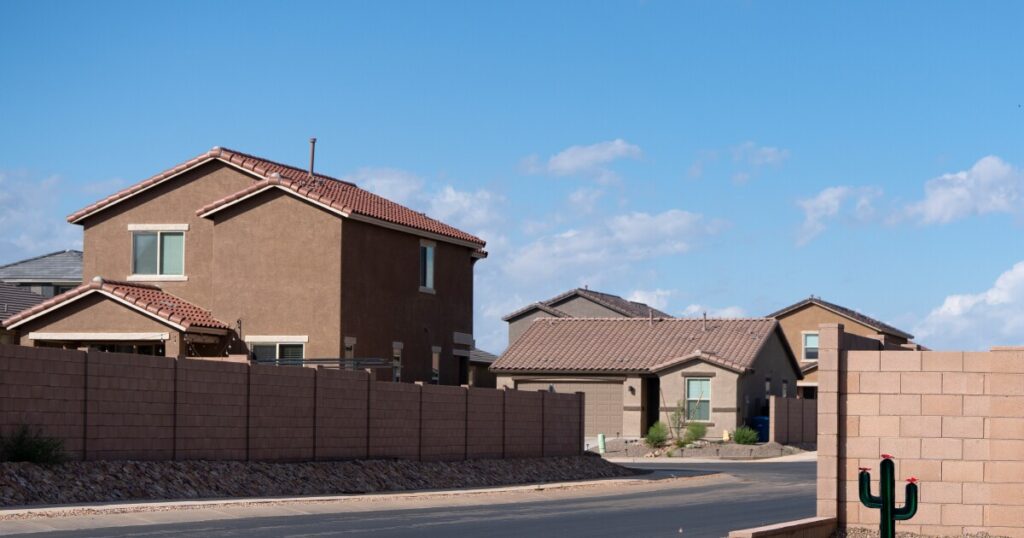A severe shortage of new homes has not stopped builders from lowering prices.
El Paso, Texas-based Tropicana Homes has seen no hesitation among consumers interested in its new construction, which according to real estate agents carries price tags above the local median price of between $220,000 and $250,000. The builder’s purchases and price reductions generate turnover, because the existing housing market is plagued by the crisis
“We match the rate from the bank they chose, and they get all their closing costs paid, including the credit report and appraisal,” says Sylvia Sandoval, a longtime salesperson with the company. “No one will walk away from a $10,000 contribution.”
The needs of the national housing market
However, that average price was unchanged from a year ago, according to federal data. The NAHB reports that about a third of builders cut prices in October, with an average price reduction of 6%. About 62% of builders took advantage of sales incentives in October, a similar pace to when rates were
“I haven’t had any setbacks waiting for a further drop in rates because if I offer them 5% or 5.25%, or just under 5%, they are comfortable,” Sandoval said. “It’s not a terrible rate, but they’re not getting 3% interest.”
Mortgage rates show no signs of weakening toward the ultra-low levels of yesteryear. On Election Day, 30-year mortgage rates were above 7%.
Nearly two-thirds of Texas builder DR Horton’s customers used the company’s financing arm, and more than 80% of them received some form of interest rate buydown in the fourth quarter of fiscal 2024, the company said in a recent earnings report. The average interest rate promotion in the period was between 4.5% and 5.5%, and has remained within the range of 1% to 1.5% below market interest rates in recent quarters.
Headwind from the builder
The factors that led to a lack of housing construction over the past decade make it more expensive to build today. Rob Dietz, NAHB senior vice president and chief economist, described the industry as facing difficulties in the five “L’s”: labor, parcels, loans, timber and legal issues.
For construction loans, interest rates range from 12% to 14%, and these funds are responsible for about 60% of a builder’s construction activity, Dietz said. Zoning regulations, along with more building, design and setback requirements have all put pressure on supply.
The trade group found in its most recent release of a five-year study that “about a quarter of the final sales prices of typical newly constructed single-family homes are not due to materials or labor, but rather to various regulatory costs, fees and taxes,” it said Dietz.
In March, the NAHB reported 76.9% of all U.S. households
Federal data showed new home prices are more palatable. In another positive sign, US Census data for September showed that sales of new homes priced under $300,000 made up 17% of new home transactions, up from 14% a year ago.
New homes could be the more affordable option in the long run compared to existing homes, experts say. Maintenance can more often be covered by a builder’s warranty, and homes are likely to be more energy efficient and more resilient to natural disasters.
Buyers are often unaware that these factors tend to be cheaper
“If it’s a brand new home under the builder’s warranty, what is a claim likely to be?” he said. “The likelihood that the homeowner is going to file a claim is probably quite slim.”
No pain, no gain
Publicly traded builders told investor analysts in earnings calls in recent weeks that their sales incentives have put a dent in their profit margins.
Atlanta-based Pulte Group acknowledged this, saying incentives were up 70 basis points in the third quarter compared to the second quarter. Texas-based DR Horton said its gross profit margin on home sales revenue fell 40 basis points in the fourth quarter of the fiscal year from the previous period, due to higher stimulus costs.
“Our margins in September were lower than in July and August, and we expect this trend to continue in the first quarter,” said Bill Wheat, the company’s executive vice president and chief financial officer. “Where rates have fallen recently, the cost of our interest rate purchases is increasing, so therefore we expect our stimulus levels to rise further.”
Dietz said he’s not sure of a “magic number” where builders would withdraw buydowns, but expects a reduction as rates move closer to 6%. Consumers can still turn to independent building societies, such as Crescenzo’s Nation One team, to work on financing.
“Our second opinion is not asked often enough,” he said. “We see tremendous success in sometimes small things, small adjustments.”
Publicly traded homebuilders said on conference calls that they are looking to the spring season to dictate future homebuilding plans. The latest data from the NAHB shows that new home sales increased both month-over-month and year-over-year in September.
A third of the current housing market is new construction, including homes where builders have not yet started construction, Dietz said.
“But historically, new construction has represented only 12% of inventory,” he said. “So high home prices on the resale side and the lock-in effect have led to new construction expanding its footprint.”


